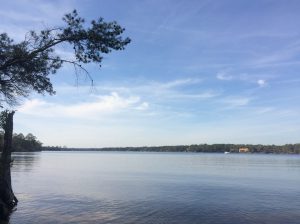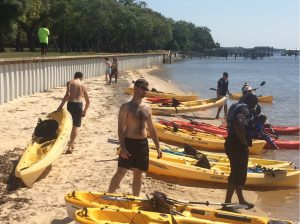September 17-24, 2016 was the nation’s 28th time to celebrate America’s coasts and estuaries during National Estuaries Week. This week helps us to remember to appreciate the challenges these coastal ecosystems face, along with their beauty and utility.
Estuaries, semi-enclosed bodies of water with both fresh and saltwater, dot the Gulf Coast of the United States from Brownsville Texas to Key West, Florida. These estuaries are important as they serve as drainage basins for many of the large river systems, and play a significant role in the nation’s seafood industry.
Florida’s six major Panhandle estuaries, which includes Perdido Bay, Pensacola Bay (including Escambia Bay), Choctawhatchee Bay, St. Andrew Bay, St. Joseph Bay and Apalachicola Bay, are unique ecosystems teeming with life and diversity. Critical habitat includes important seagrass beds that support both the larval and adult stages of fish and invertebrates. In Choctawhatchee Bay, there is also critical foraging habitat for the federally protected Gulf sturgeon (Acipenser oxyrinchus desotoi) and stream habitat for the endangered Okaloosa darter.
Choctawhatchee Bay is in Okaloosa and Walton counties in the Florida Panhandle. It is approximately 30 miles long and from three and a half to six miles wide, with a total area of 129 square miles. It is relatively shallow varying from 10 to 40 feet deep. Large portions of the western half of Choctawhatchee Bay are militarily restricted (Eglin Airforce Base). The Bay is fed by the Choctawhatchee River and numerous small creeks that feed into several bayous. The only opening to the Gulf of Mexico is the East Pass, which ironically is at the Western end of the Bay in Destin, Florida. This is where the saltwater and freshwater mix.
Continued industrial and residential development in the watershed regions that drain into many of these estuaries has impacted them in a number of ways. Pollution comes from storm water runoff, lawns, industry and farms. The shorelines are impacted by development, which causes sedimentation and in turn loss of vegetation. This reduces water clarity and habitat for wildlife.
Many organizations work to protect this estuary and reach out to others through education, restoration, and recreation events. Choctawhatchee Basin Alliance (CBA) is one such organization committed to ensuring sustainable utilization of the Choctawhatchee River and Bay. They, working with their partners, provide leadership for the stewardship of the Bay. Alison McDowell, director of the CBA, notes that 75-85% of commercially and recreationally important species that are caught in the Gulf spend part of their lifecycle in the Bay. McDowell says a key factor in the Bay’s health is monitoring the water quality and reducing erosion, and the Oyster Reef Restoration program started in 2006 does just that.
There are often opportunities for the general public to join in some of the conservation efforts taking place in the Bay. For more information, like the Okaloosa or Walton County Extension Facebook page.
- Sustainable Scalloping - August 17, 2025
- What’s Bugging You? - June 6, 2025
- Getting Your Farm Pond Ready for Spring - March 7, 2025


